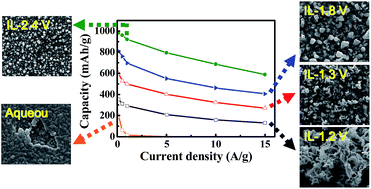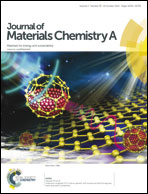Nanostructured tin electrodeposited in ionic liquid for use as an anode for Li-ion batteries†
Abstract
Nanostructured tin (Sn) is fabricated via electrodeposition in an ionic liquid (IL). The advantages of electrodeposition in IL (compared to that in conventional aqueous solution) include increased deposition current efficiency and suppressed corrosion of the Cu current collector. The former is associated with the elimination of hydrogen evolution during the cathodic deposition and the latter is attributed to the chemical benignity of ILs. It is found that the Sn morphologies can be effectively manipulated by adjusting the deposition potential in the IL plating solution. The higher the deposition overpotential, the better is the electrochemical performance of the Sn electrode for Li-ion batteries. The electrode deposited at −2.4 V, consisting of Sn nanospheres, shows a reversible discharge (delithiation) capacity of 980 mA h g−1 (at 0.1 A g−1). When the charge–discharge rate is increased to 15 A g−1, the measured capacity is as high as 588 mA h g−1. These properties are clearly superior to those of the Sn electrode deposited in aqueous solution.


 Please wait while we load your content...
Please wait while we load your content...